 W
WAgostina Segatori Sitting in the Café du Tambourin was painted by Vincent van Gogh in 1887. Agostina Segatori owned the Café du Tambourin that Van Gogh knew intimately. It was a gathering spot for Parisian artists, a place where their work was exhibited. Van Gogh, unable to pay in cash for his meals, exchanged paintings for his fare. The paintings then adorned the restaurant. He held a special exhibit of his Japanese prints in the café as well. His connection with Agostina and the cafe came to a sad end when she went bankrupt and van Gogh's paintings were confiscated by creditors. This painting, however, demonstrates an artistic discovery that culminated in his unique, creative style not quite on the brink of being understood and revered.
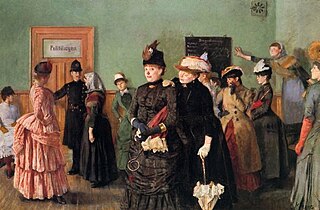 W
WAlbertine i politilægens venteværelse is the title of a naturalist painting by the Norwegian artist Christian Krohg, showing the scene in a medical waiting-room.
 W
WAsnières, now named Asnières-sur-Seine, is the subject and location of paintings that Vincent van Gogh made in 1887. The works, which include parks, restaurants, riverside settings and factories, mark a breakthrough in van Gogh's artistic development. In the Netherlands his work was shaped by great Dutch masters as well as Anton Mauve a Dutch realist painter who was a leading member of the Hague School and a significant early influence on his cousin-in-law van Gogh. In Paris van Gogh was exposed to and influenced by Impressionism, Symbolism, Pointillism, and Japanese woodblock print genres.
 W
WLa barca de Aqueronte, translated in English as The Boat of Charon or Charon's Boat, is an 1887 oil on canvas and allegorical painting by award-winning Filipino painter Félix Resurrección Hidalgo. The work was a gold medalist during the Exposicion General de las Filipinas in Madrid. In 1889, an international jury made the painting a silver medalist during the Paris Exposition, a distinct recognition that no other Filipino painter had achieved at the major art arena in Paris. The painting also won other awards such as a diploma of honor from the 1891 Exposicion General de Bellas Artes in Barcelona, a gold medal prize at the 1893 Madrid Exposicion Internacional de Bellas Artes during the 400th Anniversary of the Discovery of the Americas. The Government of Spain bought the work of art through a royal decree for the amount of 7,500 pesetas on March 7, 1893. After displaying the artwork at the Museo-Biblioteca de Ultramar and at the Museo de Arte Moderno., La barca de Aqueronte is currently placed at Madrid’s Museo Nacional de Pintura, after the Philippines became a United States territory in 1898. A smaller study of the same painting in the collection of the Lopez Museum in the Philippines.
 W
WBarques de pêche–Méditerranée is an oil on canvas painting by Belgian painter Theo van Rysselberghe. Painted in 1892, it depicts a fleet of sailboats off the southern coast of France. Van Rysselberghe's pontillist technique is well expressed in this work, whose wooden liner was painted with dots of contrasting hues serving to amplify the color harmonies in the canvas. The painting was realized by Van Rysselberghe during a two-month sailing excursion in le Midi with his close friends Paul Signac, and it offers visual representation of that sailing journey.
 W
WThe Battle of Lepanto is a painting by Filipino painter and revolutionary activist Juan Luna. Along with Félix Resurrección Hidalgo, Luna is one of the first Filipinos to excel and earn recognition in the international field of arts and culture. Painted by Luna in 1887, the masterpiece is about the Battle of Lepanto of October 7, 1571. The painting features Don Juan of Austria in battle while at the bow of a ship. It is one of the “huge epic canvasses” painted by Luna. The painting is also known as The Battle of Lepanto of 1571.
 W
WBreakfast time or Frukostdags is an oil painting completed in 1887 by the Swedish artist Hanna Pauli (1864–1940). It measures 91 by 87 centimetres and currently belongs to the Nationalmuseum which bought it in 1910. The image shows a dining table standing in a garden. Breakfast time is one of the museum's most popular images, mentioned as one of the real pearls of the 1800s.
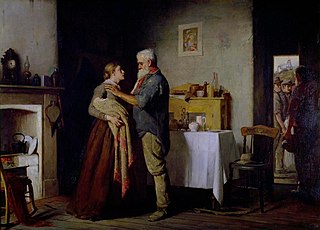 W
WBreaking the News is an 1887 painting by Australian artist John Longstaff. It shows the interior of a miner's cottage on the Victorian goldfields with an old man breaking the news to a woman of her husband's death in a mining accident. The woman holds an infant in her arms, and two other miners appear in the doorway, carrying the body of the husband on a stretcher. Behind them in the distance stands the mine's headframe. Breaking the News became etched in the popular imagination, and by the 1890s was "known by reproduction in every mining township in Australia".
 W
WBreton Women at a Pardon is an 1887 oil on canvas by the French academic painter Pascal Dagnan-Bouveret. It shows seven women sitting on grass in a churchyard waiting for a ceremony to begin. The painting is composed from somber tones and the women have a serene calmness and a demeanour described as the embodiedness of "simplicity and piety".
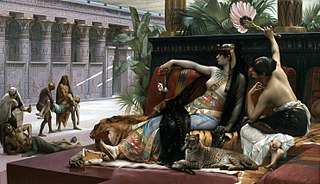 W
WCleopatra Testing Poisons on Condemned Prisoners is an 1887 painting by the French artist Alexandre Cabanel. It is held by the Royal Museum of Fine Arts Antwerp. It shows Cleopatra VII reclining on a banquette and observing the effects of poisons on prisoners condemned to death, as described in Mark Antony's Plutarch's Lives. It is considered a canonical work of 19th-century orientalism and has been used as a model for plays and early films.
 W
WA Clinical Lesson at the Salpêtrière is an 1887 group tableau portrait painted by the history and genre artist André Brouillet (1857–1914). The painting, one of the best-known in the history of medicine, shows the neurologist Jean-Martin Charcot giving a clinical demonstration to a group of postgraduate students. Many of his students are identifiable; one is Georges Gilles de la Tourette, the physician who described Tourette syndrome.
 W
WUne fleur is a female nude painted in 1887 by the Croatian artist Vlaho Bukovac.
 W
WFour Horsemen of the Apocalypse is an 1887 painting by Russian artist Viktor Vasnetsov.
 W
WGirl with Peaches is an 1887 painting by the Russian painter Valentin Serov.
 W
WHappy Brothers, Their Poor Mother! is an 1887 oil painting by the Serbian artist Uroš Predić. It shows four intoxicated youths walking through their village whilst the mother of one shouts her disapproval from the distance. The painting is said to have been inspired by a frequent sight in Predić's home village of Orlovat—that of drunken youths returning from the pub at dawn. Predić painted the composition hoping it would persuade the villagers to change their ways. He was disappointed that it not only failed to decrease the incidence of drunkenness in Orlovat, but was well received by the villagers themselves, who were happy merely to have been depicted.
 W
WJaponaiserie was the term the Dutch post-impressionist painter Vincent van Gogh used to express the influence of Japanese art.
 W
WLa Laguna Estigia, also known simply as Laguna Estigia, is an 1887 Greco-Roman painting by Filipino painter Félix Resurrección Hidalgo. It is a companion-piece for Hidalgo’s other painting entitled La barca de Aqueronte. Like the La barca de Aqueronte, the La Laguna Estigia is based on Dante's Inferno, the painter pursuing the theme leading towards a “darker” and “more somber interpretation” of it.
 W
WJohann Köler was a leader of the Estonian national awakening and a painter. He is considered as the first professional painter of the emerging nation. He distinguished himself primarily by his portraiture and to a lesser extent by his landscape paintings. Some of his most notable pictures depict the Estonian rural life in the second half of the 19th century.
 W
WLuxembourg Gardens, Paris is an oil painting by Albert Edelfelt completed in 1887 of a scene in the Jardin du Luxembourg in Paris, France. The painting has become a kind of symbol of Edelfelt and the whole of Finnish art, at a time when Paris was the center of the whole art world. The work is also a larger Edelfelt paintings and a major en plein air painting.
 W
WMary Magdalene is an oil on canvas painting by Belgian painter Alfred Stevens. It is Stevens' revision of the Biblical figure of Mary Magdalene. The work has been in the collection of the Museum of Fine Arts in Ghent since 2001.
 W
WThe Una Mestiza, sometimes referred to as La Mestiza, is an 1887 painting by Filipino painter and hero Juan Luna. The masterpiece is also known as La mestiza en su tocador which translates into English as The Mestiza at Her Dressing Table or Mestiza Lady at Her Dresser. Una Mestiza is also alternately called Charing. Coincidentally, this alternate title is the nickname of Luna's sister-in-law Rosario Melgar. Luna donated Una Mestiza to the Biblioteca Museu Victor Balaguer of Vilanova i la Geltrú in the province of Barcelona in Spain. The Una Mestiza painting won an award at the Exposicion General de las Filipinas.
 W
WThe Montmartre paintings are a group of works that Vincent van Gogh made in 1886 and 1887 of the Paris district of Montmartre while living there, at 54 Rue Lepic, with his brother Theo. Rather than capture urban settings in Paris, van Gogh preferred pastoral scenes, such as Montmartre and Asnières in the northwest suburbs. Of the two years in Paris, the work from 1886 often has the dark, somber tones of his early works from the Netherlands and Brussels. By the spring of 1887, van Gogh embraced use of color and light and created his own brushstroke techniques based upon Impressionism and Pointillism. The works in the series provide examples of his work during that period of time and the progression he made as an artist.
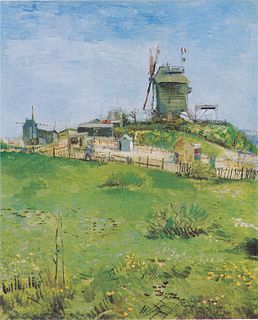 W
WLe Moulin de la Galette is the title of several paintings made by Vincent van Gogh in 1886 of a windmill, the Moulin de la Galette, which was near Van Gogh and his brother Theo's apartment in Montmartre. The owners of the windmill maximized the view on the butte overlooking Paris, creating a terrace for viewing and a dance hall for entertainment.
 W
WHenry Lerolle was a French painter, art collector and patron, born in Paris. He studied at Académie Suisse and in the studio of Louis Lamothe.
 W
WOutskirts of Paris are paintings that Vincent van Gogh made in 1887, while he was living in Paris with his brother Theo.
 W
WParade de cirque is an 1887-88 Neo-Impressionist painting by Georges Seurat. It was first exhibited at the 1888 Salon de la Société des Artistes Indépendants in Paris, where it became one of Seurat's least admired works. Parade de cirque represents the sideshow of the Circus Corvi at place de la Nation, and was his first depiction of a nocturnal scene, and first painting of popular entertainment. Seurat worked on the theme for nearly six years before completing the final painting.
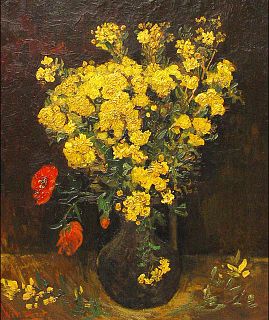 W
WPoppy Flowers is a painting by Vincent van Gogh with an estimated value of US$50 million to $55 million; it was stolen from Cairo's Mohamed Mahmoud Khalil Museum in August 2010 and has yet to be found.
 W
WPortrait of Père Tanguy, painted by Vincent van Gogh in 1887, is one of his three paintings of Julien Tanguy. The three works demonstrate a progression in van Gogh's artistic style after his arrival in Paris. The first is somber, and formed from a simple composition. The second introduces van Gogh's Japanese prints. The last and most advanced in style, skill and color integrates Japanese, Impressionist, and other influences on the Parisian artist community. This painting conveys a sense of serenity that van Gogh seeks for himself. This last painting of Tanguy is in the Musée Rodin, Paris.
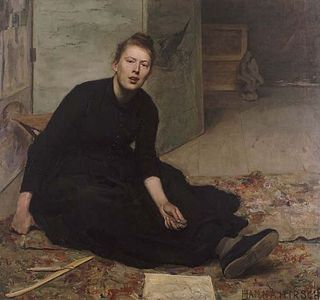 W
WPortrait of Venny Soldan-Brofeldt is an oil painting by Hanna Pauli from 1887.
 W
WPortrait of Vincent van Gogh is an 1887 chalk pastel on cardboard by Henri de Toulouse-Lautrec. Toulouse-Lautrec had encountered Vincent van Gogh, eleven years his senior, when they were both taking lessons at the open studio of Fernand Cormon in Paris from 1886 to 1887. The painting is held by the Van Gogh Museum in Amsterdam, catalogued "d693V/1962".
 W
WSailboats and Estuary is an oil on canvas painting by Belgian painter Theo van Rysselberghe. Painted around 1887, it shows a coastal landscape elaborated in a Pointillist technique. Van Rysselberghe probably adopted the Pointillist manner after befriending Signac; however, the use of color in Sailboats and Esuary is nonetheless far more realistic than in paintings by Signac and other Neo-Impressionists, and reveals a tendency towards naturalism. The artwork has been in the collection of the Musée d'Orsay in Paris since 1982, on loan from the Louvre.
 W
WSeine (paintings) is the subject and location of paintings that Vincent van Gogh made in 1886. The Seine has been an integral part of Parisian life for centuries for commerce, travel and entertainment. Here van Gogh primarily captures the respite and relief from city life found in nature.
 W
WStill life paintings by Vincent van Gogh (Paris) is the subject of many drawings, sketches and paintings by Vincent van Gogh in 1886 and 1887 after he moved to Montmartre in Paris from the Netherlands. While in Paris, Van Gogh transformed the subjects, color and techniques that he used in creating still life paintings.
 W
WSunflowers is the name of two series of still life paintings by the Dutch painter Vincent van Gogh. The first series, executed in Paris in 1887, depicts the flowers lying on the ground, while the second set, made a year later in Arles, shows a bouquet of sunflowers in a vase. In the artist's mind both sets were linked by the name of his friend Paul Gauguin, who acquired two of the Paris versions. About eight months later van Gogh hoped to welcome and to impress Gauguin again with Sunflowers, now part of the painted Décoration for the Yellow House that he prepared for the guestroom of his home in Arles, where Gauguin was supposed to stay. After Gauguin's departure, van Gogh imagined the two major versions as wings of the Berceuse Triptych, and finally he included them in his Les XX in Bruxelles exhibit.
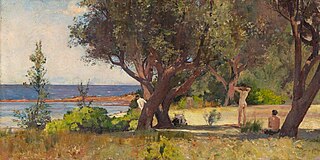 W
WThe Sunny South is a 1887 painting by the Australian artist Tom Roberts. The painting depicts a group of boys swimming naked at Ricketts Point at Beaumaris, Victoria, a suburb of Melbourne.
 W
WTorso of Venus and a Landscape is a sketch by Post-Impressionist artist Vincent van Gogh. It now resides in the Van Gogh Museum in Amsterdam.
 W
WTrees and Undergrowth is the subject of paintings that Vincent van Gogh made in Paris, Saint-Rémy and Auvers, from 1887 through 1890. Van Gogh made several paintings of undergrowth, a genre called "sous-bois" brought into prominence by artists of the Barbizon School and Impressionists. The works from this series successfully use shades of color and light in the forest or garden interior paintings. Van Gogh selected one of his Saint-Rémy paintings, Ivy (F609) for the Brussels Les XX exhibition in 1890.
 W
WView of Paris from Vincent's Room in the Rue Lepic is a painting by Dutch post-impressionist artist Vincent van Gogh.
 W
WWestern Cattle in Storm is a $1 stamp issued by the United States Post Office Department as part of the 1898 Trans-Mississippi Issue. Western Cattle in Storm is one of nine commemorative postage stamps in the series, which marked the 1898 Trans-Mississippi Exposition held in Omaha, Nebraska. While the entire Trans-Mississippi Issue set has been praised for its quality, viewed by generations of U. S. stamp specialists as "one of the most beautiful sets of postage stamps our country has ever issued," the $1 stamp, also called the Black Bull, stands out from the rest.
 W
WIn 1887, while Vincent van Gogh was residing in Paris, he executed an oil painting commonly known as Wheat Field with a Lark.
 W
WA Woman Walking in a Garden was painted by Vincent van Gogh in 1887. As the title indicates, it depicts a woman walking through a garden. Greenery is everywhere and numerous trees can be seen in the background.